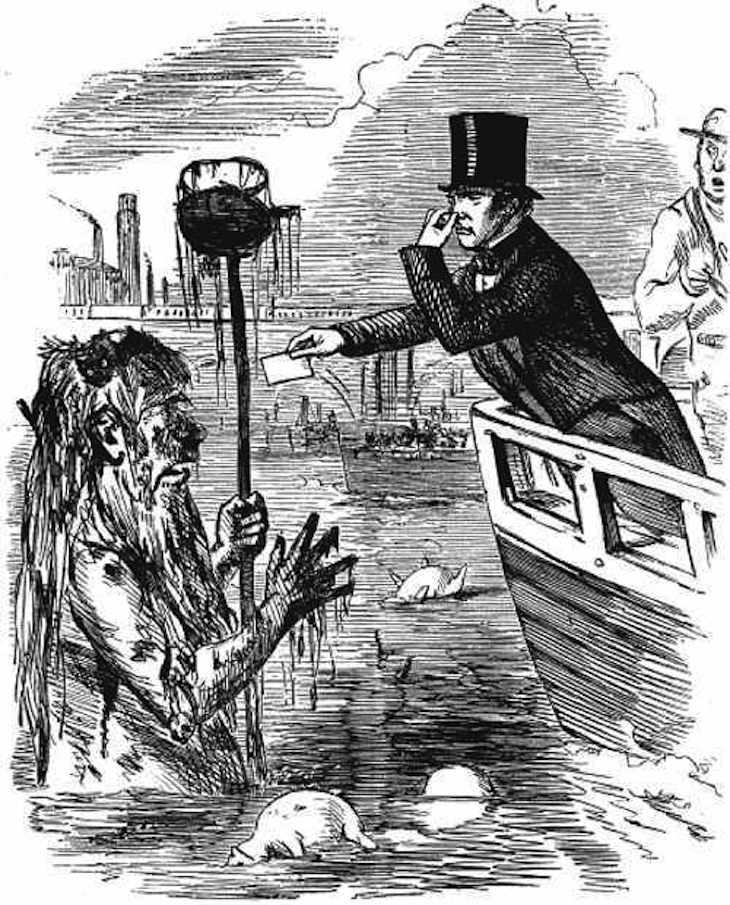
A naked demigod stands guard over the Nine Elms riverbank. The tangerine deity tussles with a frutti di mare of dolphins, fishes, giant anemones, a playful water baby and a skulking octopus. The polychrome relief, designed by Stephen Duncan in 1988, is a monument to Father Thames, London's very own river god. But who is this nudesome fellow? Where did he come from?
Ancient origins
Rivers, bringers of life, have long been associated with sprites, spirits, deities and other supernatural beings. No one knows quite how long ago the figure of Father Thames was first invoked. It's likely that people have always paid obeisance to the river in one form or another. Archaeologists have plenty of evidence for river worship in London. Treasures like the Iron Age Battersea Shield (shown below) might have been votive offerings, given in deference or placation to the river.

This beautiful object was dredged from the river in 1857, not far from where the Father Thames sculpture now resides. You can view it in the British Museum, near to a horned helmet of similar age, found below Waterloo Bridge in 1868.
Peter Ackroyd in his 2007 biography of the river reckons Father Thames "bears a striking resemblance to the tutelary gods of the Nile and the Tiber". Gods such as the Roman Tiberinus share the long hair and beard of Father Thames. Ackroyd sees their flowing follicles as simulacra of the river itself. Meanwhile, the Egyptian goddess Isis had strong connections to the River Nile, and also lends her name to parts of the Thames, especially in the sections through Oxford where the river is usually called The Isis. The connection is strengthened in a couplet by 18th century poet Matthew Prior:
Where beauteous Isis and her Husband Tame
With mingl'd Waves, for ever, flow the Same
Where to see Old Father Thames
London's most impressive representation of the river god can be found in Trinity Square, near The Tower. The divinity perches high on the former Port of London Authority building. He is again shown naked, save for a rather impractical cloak that must inhibit his swimming. He clutches a Poseidon-like trident in his right hand, while his left hand points east towards the sea.

Ackroyd provides a helpful list of other representations of the god. Find him at Ham House, Somerset House, Hammersmith Town Hall and Kew Bridge. And then, of course, there's that strange bas-relief on the Nine Elms river front, shown at the top. In fact, you can find the god's hirsute noggin at various places along the Embankment if you keep your eyes peeled. Beyond London, a statue of the deity can be found guarding Lechlade, site of the first lock on the river. Another sculpture guards Henley Bridge.
Father Thames in art and literature

The most evocative depiction of Papa Thames in the whole of art must be the frontispiece to Doré and Jerrold's 1868 book London: A Pilgrimage. Our favourite river deity skulks beneath a riverside arch, and for once without his balls on show. He peers over his shoulder at a Britannic lion. It may not be based on actual events.
One of the oldest literary references to Old Father Thames comes in Alexander Pope's 1713 expansion of his poem Windsor Forest:
Old Father Thames advanced his reverend head;
His tresses dropp'd with dews, and o'er the stream
His shining horns diffused a golden gleam:
Grav'd on his arm appear'd the moon that guides
His swelling waters and alternate tides:
The figur'd streams in waves of silver roll'd,
And on her banks Augusta rose in gold.
(Augusta is an ancient name for London.) Pope's example was followed by many others, the bearded man serving as a romantic personification of the Thames. The device perhaps reaches its apotheosis in the Rivers of London novels of Ben Aaronovitch. Father Thames features as a character, and he's joined by Mama Thames and a whole family of daughter rivers such as Lady Ty (Tyburn), Fleet, Lea and Beverley Brook.
Old Father Thames has also had his dark days. During the Great Stink of the 1850s, the River Thames honked with raw sewage to such an extent that the Houses of Parliament had to close down. Cartoonists of the day drew many images of a woebegone Father Thames, wallowing in his filthy abode.









